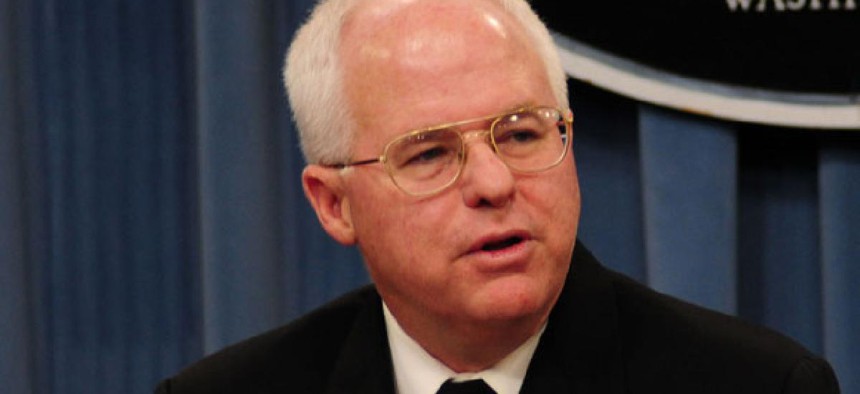
"Our issue on furloughs is to get down to zero or get support and push that way, because we have a dramatic impact on our equipment and our readiness,” Rear Adm. Joe Mulloy, deputy assistant secretary of the Navy for budget, said Defense Department file photo
Defense May Reduce Furloughs Again as Navy Pushes to Eliminate Them
Forced unpaid leave could cost more than it saves, official says.
This story has been updated.
Navy officials are pushing for zero furlough days, according to a top official, as the Pentagon reportedly considers reducing all Defense furloughs and hasn’t ruled out eliminating them entirely.
Rear Adm. Joe Mulloy, deputy assistant secretary of the Navy for budget, on Wednesday emphasized the importance of the service’s civilian workforce. He noted that 85 percent of the Navy’s civilian workforce and 93 percent of the Marine Corps’ are based outside of Washington, working to support military personnel in all operational areas.
“Hence, our issue on furloughs is to get down to zero or get support and push that way, because we have a dramatic impact on our equipment and our readiness,” Mulloy said during the service’s fiscal 2014 budget rollout.
A Navy official later told Foreign Policy that the service was “pursuing an option to realize $300 million in savings in other areas” because they believe the longer-term costs of unpaid civilian furloughs would be far more expensive.
The Defense Department may not be fully on board. Although Congress granted the department limited budgeting flexibility under sequestration, Defense spokeswoman Cmdr. Leslie Hull-Ryde told Government Executive on Thursday that the Pentagon “is implementing furloughs with consistency across the department.”
Late Thursday, the Associated Press reported that Pentagon officials were considering reducing furlough days for all Defense civilians and haven’t ruled out eliminating them entirely. After originally scheduling 22 departmentwide sequestration furlough days in 2013, the Pentagon in March reduced that number to the currently scheduled 14.
The unnamed source cited by Foreign Policy said the Navy was prepared to follow departmentwide guidance but was still in discussions with the Office of the Secretary of Defense.
Civilians across the department face a number of different prospects in fiscal 2014 that vary by service branch. Within the Pentagon’s proposed $526.6 billion fiscal 2014 budget, $77.3 billion is directed toward civilian pay.
Navy civilians could remain relatively unscathed. The Navy’s budget proposal sees the number of full-time or equivalent civilians, FTEs, growing marginally to 202,947 in fiscal 2014, from 201,148 in fiscal 2013.
The Army takes the biggest hit in the president’s budget, with its civilian FTEs dropping from 273,079 in fiscal 2013 to 264,053 in fiscal 2014. The Air Force’s civilian FTEs would remain essentially flat at 184,000 in fiscal 2014.
The Navy still will face tighter spending in other areas, including flying hours, investment and infrastructure, according to Mulloy.
“We will continue to modernize within affordability constraints and will continue to uphold our commitments to our soldiers, families, and our civilian employees,” Mulloy said.
On Sunday, the Navy released talking points outlining the impact that across-the-board budget cuts from sequestration would have on the service. The cuts could affect nearly 94 percent of the Navy’s civilian workforce, according to the memo, which presented a starker outlook than the recent comments from officials.
NEXT STORY: OPM Director Berry Bids Farewell to Employees







